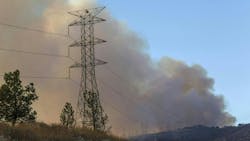Stopping the Fire Before it Starts: Wildfire Mitigation for Utilities
Years and years ago, I was working my very first job in newspapers after college in a small Oklahoma town. It was an extremely dry summer, which is unusual as the Sooner State typically has stormy summers. I was talking to some local firefighters about the fire risk, and what might lower the risk of people accidentally sparking a fire. That was where I learned that firefighters refer to anything in the path of a fire that can be burned as “fuel.” That means forests, grass, shrubs, etc.
Now I live out West in Oregon’s Willamette Valley and have friends who work in forestry services. They too use the word fuel this way. It makes me think that if fire were a living, thinking being, it would think of anything dry or exposed enough to burn as its fuel. I suppose if you are in the wildfire mitigation business, one must think like a fire would. Denying a fire its fuel is only one method of controlling wildfires.
The toolkit utilities have today for limiting the risk of fire continues to grow, and these Wildfire Mitigation supplements always give me a chance to stay up to date on the techniques and tactics applied to halt deadly blazes before they start.
Unfortunately, the threat of wildfires continues to grow and spread with all the fury of an out-of-control blaze. I wanted this issue to stress this point, and that is why you will see the growing geography of the problem. When we put out the call for contributions to this issue, we got responses from electric utilities in Arizona, California, Idaho, Canada and even South Korea (not all of these could be prepared in enough time to get them in the issue). In past issues, we also heard about people in Australia and Israel-Palestine who were looking into wildfire solutions, strategies and systems.
2024 Wildfire Mitigation Supplement
And of course, one of the biggest news stories of the past year was the blaze that engulfed Hawaii, in particular Maui’s historically fascinating port town of Lahaina, which lost some 80% mostly residential structures to the wildfire, as well as scores of people. In Hawaii, the danger comes from a similar trend as it does in many others: Drying conditions, hotter air temperatures and the unchecked spread of non-native or invasive vegetation.
What this adds up to is: Utilities in places you might not associate with extreme fire danger still have to think much about this problem. Electric utilities with service territories that previously did not need to worry about fire prevention all that much are now finding themselves stepping up their mitigation efforts, policies, hiring, modeling and planning.
Something I learned since coming to live in the Pacific Northwest is some wildfires are simply too massive and fast-spreading to even attempt to fight. The phrase “0% containment” becomes pretty terrifying if your home is near these kinds of wildfires.
It turns out Smokey Bear was correct — it’s always preferable to prevent a fire than to fight one, no matter how ready you think you are for that fight. Most of the mitigation technology and techniques we use in the utility industry are designed to prevent fires from sparking, remove fuel from potential fires or prepare for the outages that may result.
Keeping a close eye on power lines can be achieved with sensors, networked systems, thermal cameras and other data collection techniques. This obviously produces a lot of data, but some utilities are applying machine learning/artificial intelligence to the problem, which they say makes spotting a potential area of failure on specific equipment much easier.
Something I had not heard of before until this year is lines that aren’t overhead or underground, but along the ground. This is something Pacific Gas & Electric Co. is working on, and they call it ground-level distribution system (GLDS). Instead of burying lines, the utility covers lines with specially built conduits that use basalt rebar ties, geopolymer cement and thermoplastic caps to create a sort of elongated box for power lines. This prevents vandalism, but it also shields the area from any sparks. Undergrounding can’t be done everywhere, it is expensive and lines are hard to get to again once you have buried them. From what I have read about GLDS, it sounds like it combines the best qualities of overhead and underground — at least from a wildfire prevention and utility servicing perspective.
I am always glad to work on our Wildfire Supplement issue because it is so important to track the progress the industry is making on this problem. I end up with a feeling that even though wildfires are growing more destructive and deadly, there are some extremely smart and talented people out there working on halting fires before they become out-of-control blazes.
About the Author
Jeff Postelwait
Managing Editor
Jeff Postelwait is a writer and editor with a background in newspapers and online editing who has been writing about the electric utility industry since 2008. Jeff is senior editor for T&D World magazine and sits on the advisory board of the T&D World Conference and Exhibition. Utility Products, Power Engineering, Powergrid International and Electric Light & Power are some of the other publications in which Jeff's work has been featured. Jeff received his degree in journalism news editing from Oklahoma State University and currently operates out of Oregon.
